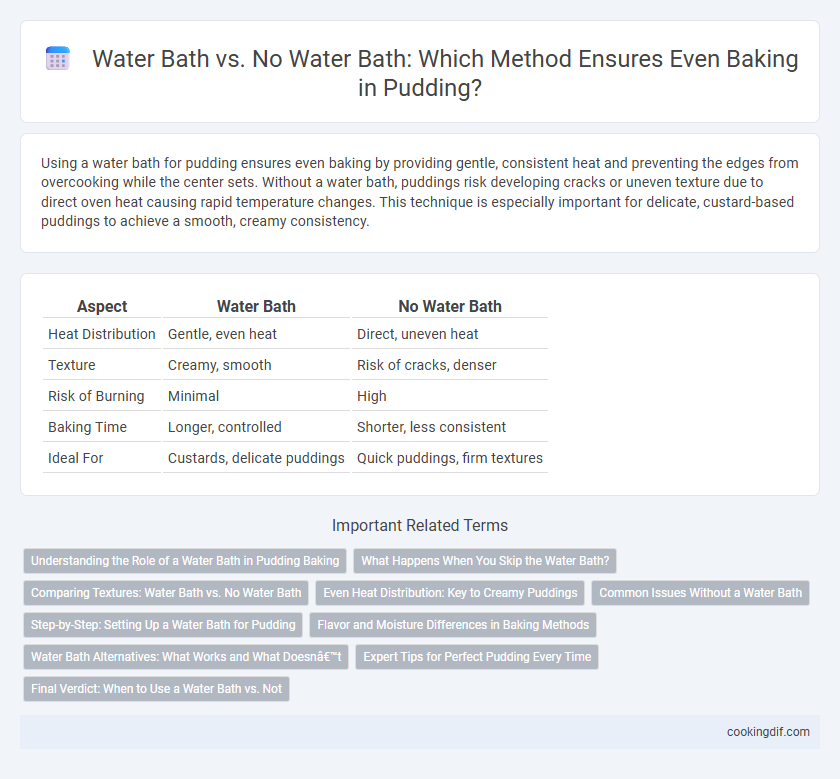Using a water bath for pudding ensures even baking by providing gentle, consistent heat and preventing the edges from overcooking while the center sets. Without a water bath, puddings risk developing cracks or uneven texture due to direct oven heat causing rapid temperature changes. This technique is especially important for delicate, custard-based puddings to achieve a smooth, creamy consistency.
Table of Comparison
| Aspect | Water Bath | No Water Bath |
|---|---|---|
| Heat Distribution | Gentle, even heat | Direct, uneven heat |
| Texture | Creamy, smooth | Risk of cracks, denser |
| Risk of Burning | Minimal | High |
| Baking Time | Longer, controlled | Shorter, less consistent |
| Ideal For | Custards, delicate puddings | Quick puddings, firm textures |
Understanding the Role of a Water Bath in Pudding Baking
A water bath in pudding baking creates gentle, even heat by surrounding the custard with moist air, which prevents curdling and promotes smooth texture. Baking pudding without a water bath risks uneven cooking, resulting in cracked surfaces and grainy consistency due to direct oven heat. Using a water bath ensures a creamy, tender pudding by regulating temperature and maintaining moisture throughout the baking process.
What Happens When You Skip the Water Bath?
Skipping the water bath during pudding baking causes uneven heat distribution, leading to cracked or overcooked edges and a curdled texture. Without the gentle, consistent moisture from boiling water, the pudding's surface can dry out and bubble, compromising the smooth, creamy consistency. Using a water bath helps maintain stable baking temperature, ensuring even cooking and the perfect silky finish essential for classic pudding.
Comparing Textures: Water Bath vs. No Water Bath
Using a water bath for pudding ensures gentle, even heat distribution, resulting in a smooth, creamy texture without cracks. In contrast, baking without a water bath can cause uneven cooking and a denser, sometimes rubbery texture due to direct heat exposure. The moisture from the water bath also helps maintain pudding's delicate consistency by preventing the edges from overcooking.
Even Heat Distribution: Key to Creamy Puddings
Using a water bath ensures even heat distribution, which is crucial for achieving creamy, smooth puddings by preventing the edges from cooking faster than the center. Without a water bath, direct oven heat can cause uneven cooking, leading to curdled or rubbery textures. This method maintains gentle, consistent heat around the dish, resulting in the ideal silky pudding consistency.
Common Issues Without a Water Bath
Baking pudding without a water bath often results in uneven cooking, causing the edges to overcook while the center remains undercooked. This common issue arises because direct heat leads to rapid temperature changes, increasing the risk of cracking or curdling in custards and delicate puddings. Using a water bath creates a gentle, consistent heat that prevents these problems by maintaining stable moisture and temperature throughout the baking process.
Step-by-Step: Setting Up a Water Bath for Pudding
Setting up a water bath for pudding ensures even baking by maintaining a consistent temperature and preventing the custard from curdling or cracking. To create a water bath, place your pudding dish inside a larger baking pan, then carefully pour hot water into the outer pan until it reaches halfway up the sides of the pudding dish. Baking in this moist, insulated environment gently cooks the pudding, resulting in a smooth, creamy texture compared to baking without a water bath that risks uneven cooking and dryness.
Flavor and Moisture Differences in Baking Methods
Using a water bath for pudding baking ensures gentle, even heat distribution that enhances moisture retention and produces a creamy, smooth texture, preventing curdling and cracked surfaces. Baking without a water bath exposes the pudding to direct oven heat, often resulting in drier edges and a denser texture with less subtle flavor development. The water bath method retains delicate custard flavors and silky moisture, making it ideal for classic, rich puddings like flan or creme brulee.
Water Bath Alternatives: What Works and What Doesn’t
Water bath alternatives such as silicone molds, double boilers, or low-heat ovens can offer more controlled, even baking for puddings, reducing the risk of cracking or uneven texture. Using foil wraps or placing the baking dish inside a larger pan with hot water mimics the gentle heat distribution of a traditional water bath, ensuring smooth, creamy results. In contrast, skipping a water bath altogether often leads to dry edges and uneven cooking, especially in delicate custard-based puddings.
Expert Tips for Perfect Pudding Every Time
Using a water bath for baking pudding ensures gentle, even heat distribution, preventing cracks and curdling by maintaining consistent moisture levels. Experts recommend wrapping the dish in foil and placing it in a hot water bath to achieve smooth, creamy textures and avoid overcooking around the edges. Skipping the water bath often leads to uneven cooking and a less delicate consistency, making it essential for flawless pudding results.
Final Verdict: When to Use a Water Bath vs. Not
Using a water bath in pudding baking provides gentle, even heat that prevents cracking and curdling by maintaining consistent moisture and temperature around the custard. Skip the water bath for firmer puddings or recipes that benefit from direct heat, such as bread puddings, where a crisp top is desired. Opt for a water bath when baking delicate, creamy puddings like flan or creme brulee to ensure smooth texture and precise cooking.
Water bath vs no water bath for even baking Infographic

 cookingdif.com
cookingdif.com